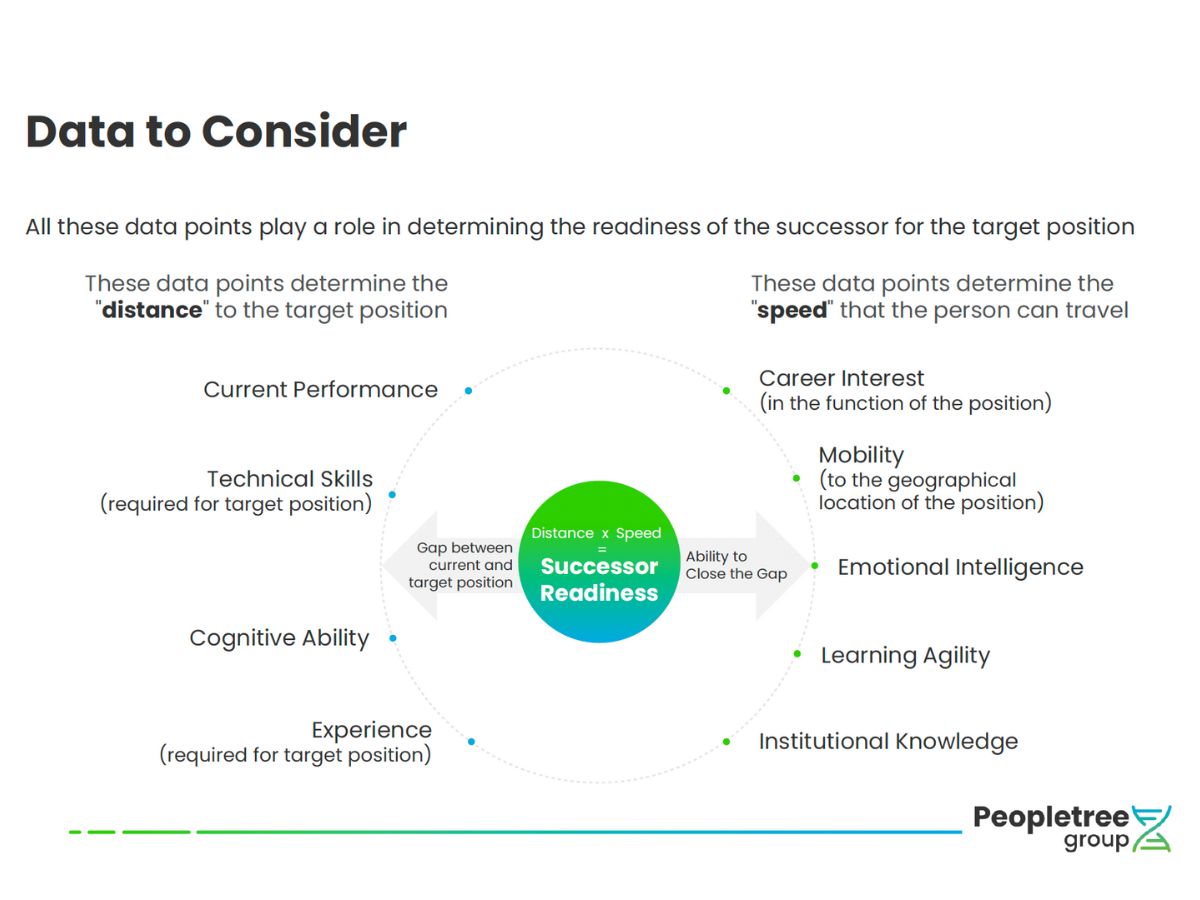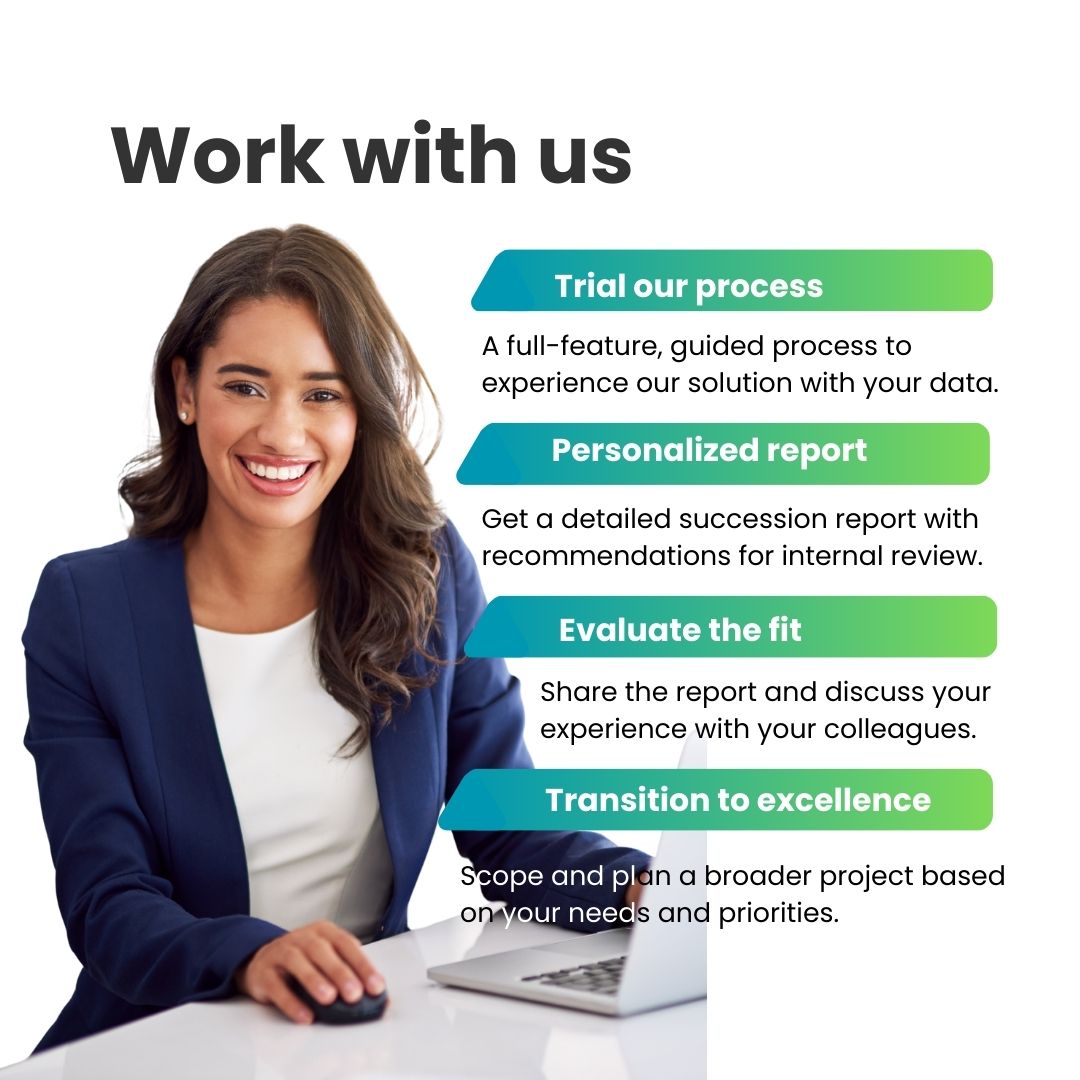There is a lot of conflicting information about succession planning.
If you view succession planning as an annual exercise of nominating successors for leadership positions, and enrolling those individuals into development courses, you’re not the only one.
But there is a fundamental problem with this process if the successors you nominate don’t end up in the roles they were intended for. And without leaders in critical positions, your company won’t be in a position to adapt quickly to unexpected changes in the environment. You can read more about the high cost of poor succession planning here.
In this article, we’ll uncover:
- The top questions we hear about succession planning
- Why the current view of succession planning is not producing successors that succeed
- What you can do to fix it.
Is your succession process strengthening your succession pipeline?
Find out how to put your money where it matters by investing in the right successors for all your critical roles.
Take our succession assessment to find out.
Why is succession planning important?
Succession planning is critical for the long-term survival of any organization.
- Mitigates risk: It helps keep a steady supply of talent into critical positions, and prepares the company for unexpected changes in leadership.
- Keeps employees engaged: It sends a message to employees that the company cares about their career growth and development, which improves engagement and also helps to retain top talent.
- Retains knowledge: It retains critical institutional knowledge and skills.
- Reduces costs: Prevents unnecessary recruitment and hiring costs, especially at an executive level by developing and promoting internal employees.
- Ensures strategic fit: It helps align future leaders with the company’s strategic direction and goals.
- Guides training and development: Succession readiness assessments highlight key areas for growth, such as skills, competencies and experience. With proper succession planning, you can tailor your development plans and stop wasting resources on the wrong successors, or on unnecessary training and development.
What is succession planning?
People often use the terms “succession management” and “succession planning” interchangeably. We prefer to use the term succession management, which goes beyond traditional succession planning. Lets look at the difference between succession planning and succession management.
The difference between succession planning and succession management
Succession planning is the process of identifying and developing new leaders to replace current leaders when they leave. The goal of succession planning is to ensure the continuity of critical positions.
Succession management takes a broader approach that aims to build a talent pipeline within an organization to support long-term strategic growth and unexpected change. Simply put, succession management is about estimating the time of arrival of future successors and preparing them to take over seamlessly.
The difference between succession planning and succession management, is in how accurately you measure time-to-readiness (the “gap”), what the successor needs to prepare them for their future role and how fast you can close the gap.
Succession management isn’t just about looking at whether a successor is “ready now” or “ready later”. You need to determine both the distance of identified successors from their target position and the speed that they are travelling to accurately predict their time of arrival, and to provide the resources they need tog et them there.
What are the key elements in managing succession?
There are 5 steps in succession planning. Let’s dive into the 5 steps of writing an effective succession plan:
Identify critical roles
The first step in succession planning is knowing what your strategic objectives are and defining the company’s goals. If you understand the direction your company is going in, you can better identify the key roles that are essential to your business operations now, and for the future.
Identify any significant business challenges you’re anticipating in the next 1 to 5 years. Now look at all the critical positions that will be needed to support the business.
Remember that succession planning is not only for leadership positions. All roles which fall into the below categories should be considered as critical roles:
- All roles that have a high impact on business performance, operations or strategic goals
- Roles that involve a high level of leadership, decision-making or risk
- Roles that might not be important now, but will be vital for the future needs of the business
- Roles that require a scare skill, specialised knowledge, experience or training and roles that are in high demand in the market.
Complete a talent assessment of every potential candidate for the role
A common mistake that many companies make, is not identifying all possible successors for their critical roles. Instead, they nominate successors for their visibility. To identify every possible successor, you need to establish clear criteria for each critical position including skills, competencies, experience or knowledge and behavioral criteria.
A succession readiness assessment should give you an accurate time to readiness. Vague descriptions like, “ready now”, “ready later”, or “ready in 1 – 2 years” are not helpful descriptions of readiness. The difference between “ready in one year” and “ready in two years” is significant. This is where the right succession assessment tools matter.
There are many different succession assessment tools out there, but the trouble is that many companies are overly reliant on one assessment tool (like a personality assessment), or they only evaluate current performance and don’t consider what will be required for the future role.
To make better decisions about successors, you need to consider multiple factors. At Peopletree Group, we assess readiness using 9 different data points. Each of these data points helps us to determine the distance (gap between where they are now and their target position) and the speed (how fast we can get them there).
Distance data points include:
- Current performance
- Technical skills (for target position)
- Cognitive ability
- Experience
Speed data points include:
- Career interest (in the function of the position)
- Mobility (geographical location of the position)
- Emotional intelligence
- Learning agility
- Institutional knowledge

Close the gap with talent development and training
Once you have assessed your pool of successors, and you have an accurate prediction of their time to readiness, you can create personalized development plans for each successor.
This should include training to close the distance gap (skills-based training, cross-training and exposure) as well as the speed gap (leadership development programs and mentoring,).
A common pitfall in the development process, is that nobody is allocated the task of preparing the successor for their future role. The current incumbent is not the right person to prepare their successor. They do need to be as involved as possible in transferring their knowledge to the successor, but the “successor developer” should ideally be the current incumbents manager, or the person that will be responsible for making the final hiring decision.
Review and track your succession plan
Once you’ve implemented a development plan to prepare the successor, you need to hold regular review meetings to discuss development progress and challenges. This includes regularly reevaluating a successor’s readiness and making changes to the development plan if needs be.
Transition planning
When the successor is ready, based on their readiness assessment, plan a smooth handover of duties from the current leader to the successor. This transition process may include a gradual handover of responsibilities, shadowing or overseeing of responsibilities from the current incumbent until the successor feels confident enough to manage on their own. In some instances, this handover period will be short, and in other instances, especially in the instance of a large jump in decision-making authority, the successor may need more time.
Succession planning software and technology
The most important function of strategic HR is to provide fast, accurate answers to the “Who?” questions business leaders ask.
Both speed and accuracy matter.
Speed: If HR can’t provide a speedy response, business leaders turn to someone else. By being able to provide an answer quickly, HR establishes itself as a reliable business partner.
Accuracy: If HR provides the wrong answer, business leaders will fall back on their own (opinion-based) judgement. By providing accurate answers HR demonstrates its value as a trusted and competent expert.
The software and technology you choose to implement should enhance both the speed and accuracy of getting to these answers.
If your data is incomplete, it limits your ability to answer accurately (because you’re not forming a complete picture). If your data is difficult to access (e.g. you have multiple disparate systems) or the data takes too long to collect and analyze, it limits your ability to answer questions quickly.
Ultimately, your succession software and systems should provide you with fast, accurate answers to the question: “Who is our next leader?”
If you’ve been managing your succession process with disparate software systems, manual spreadsheets or missing data, it may be time to upgrade to an end-to-end succession solution.
The Peopletree Group succession solution looks at your data, processes, technology/ software, and culture and implements a solution that will ensure a constant supply of available successors for critical positions.
Our approach is to design a solution with you, by simplifying your tools, technology, systems, and processes. We provide IT, data management, infrastructure, data visualization, HR, and change management skills that deliver a solution, not a product.








